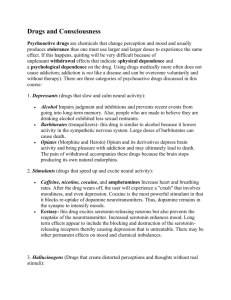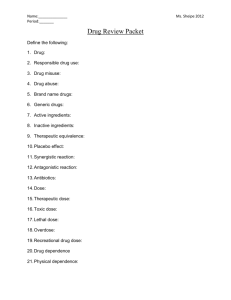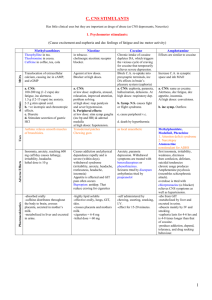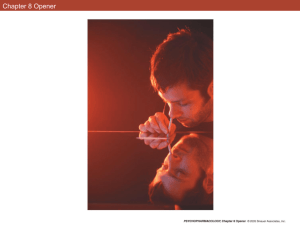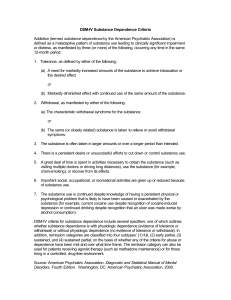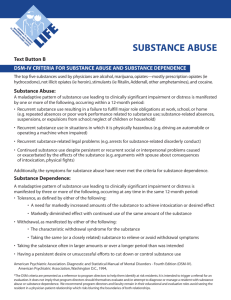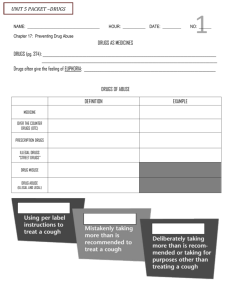drug of abuse
advertisement
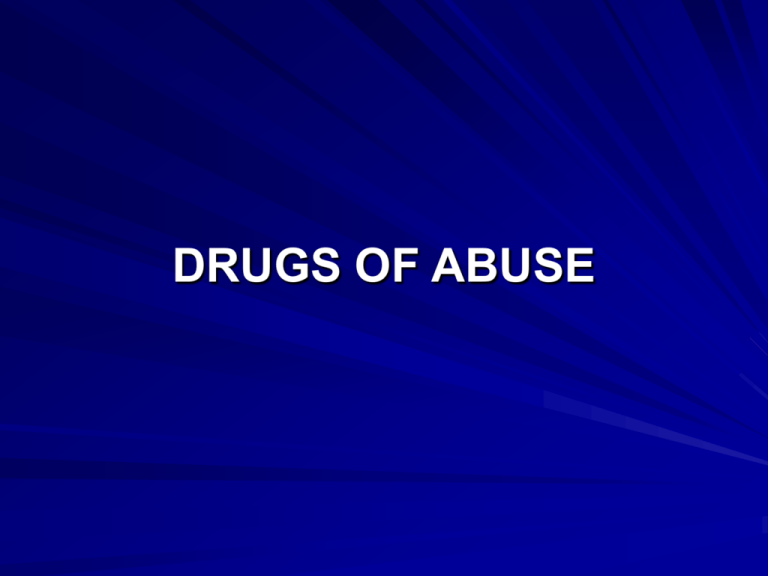
DRUGS OF ABUSE DEFINITIONS: Abuse - any use of a drug for non-medical purposes, almost always, for altering consciousness Misuse Use of a drug for the wrong indication or wrong dosage Addiction a state of psychic or physical dependence Psychologic dependence compulsive drug seeking behavior for personal satisfaction like heavy cigarette smoking Physiologic dependence - - is present when withdrawal of the drug produces signs and symptoms that are frequently the opposite of those sought by the user ( eg. = alcohol or coffee withdrawal) - Tolerance a decreased response to the effects of the drug requiring ever larger doses to achieve the same effect Metabolic tolerance – due to increased disposition of the drug Behavioral tolerance – an ability to compensate for the drug's effects Functional tolerance - due to compensatory changes in receptors, enzymes or membrane actions of the drug CULTURAL CONSIDERATIONS: 1. USA - caffeine, nicotine and alcohol are legal 2. Middle East - cannabis ( marijuana ) is legal while alcohol is illegal 3. American native tribes - peyote, a hallucinogen, is legal for religious purposes 4. Andes of South America - cocaine is used to allay hunger & enhance the ability to work at high altitude" the price to pay for considering drugs as illegal is the criminal activity related to it like: 1. illegal traffic for profit 2. user may resort to robbery, prostitution or violent crimes KINDS =Opiates & opioids - opium, heroin, morphine, oxycodone, meperidine = Depressants & other - barbiturates, alcohol, sedatives bromide, benzodiazepines = Stimulants - caffeine, nicotine, cocaine, amphetamine = Hallucinogens - LSD, mescaline, psilocybin, phencyclidine, ketamine = Cannabinoids - marijuana = Inhalants - anesthetics - chloroform, ether, halothane, nitrous oxides - industrial solvents - hydrocarbons - aerosol propellants - fluorocarbons - organic nitrites - amyl nitrites, butyl nitrites = Steroids SCHEDULE POTENTIAL COMMENTS OR CLASS FOR ABUSE CLASS I CLASS II High High No accepted medical use, lack of accepted safety as a drug Abuse may lead to psychophysical dependence. No telephone prescription. No refill SAMPLE Narcotics = heroin Hallucinogens = LSD Opioids = opium Alkaloids = morphine = hydromorphone = oxymorphone = oxycodone Synthetic = meperidine (Demerol) = methadone = levorphanol = fentanyl (Sublimaze) CLASS II Stimulants = cocoa leaves = cocaine amphetamine Depressants = Barbiturates amobarbital pentobarbital secobarbital Cannabinoids - Dronabinol CLASS III Less than I and II Moderate or low potential for physical dependence with high potential for psychological dependence. Prescription must be rewritten after 6 months. Can be given up to 5 refills Opioids codeine dihydrocodeine hydrocodeine opium (paregoric) Stimulants benzphetamine Phendimetrazine Depressants barbiturates in Class II in suppository form aprobarbital butarbital gluthetimide metharbital talbutal thiamylal thiopental (Penthotal) Steroids CLASS IV Less than that of Class III Opioids Limited potential for Difenoxin dependence. Pentazocine Propoxyphine Prescription must be rewritten after 6 months. Given up to 5 refills. Lesser penalty for illegal use than that in Class III Stimulants Diethylpropion Mazindol Phentermine (Ionamin) Fenfluramine Pemoline Depressants Benzodiazepines Chloral hydrate Meprobamate Phenobarbital CLASS V Less than that of Class IV Limited Opioids dependence Diphenoxyis possible. A nonopioid. May be dispensed w/o a prescription late (Lomotil) OPIATES & OPIOIDS: History - opium smoking - widely practiced in China - recently - injecting morphine is increasing in the West = 400,000 - 600,000 in the US alone Chemistry & Pharmacology: -most commonly abused = Heroin, morphine, meperidine , oxycodone =tolerance to mental effects develop w/ chronic use = the need of ever increasing amounts to sustain the desired euphoriant effects & avoid withdrawal symptoms causes dependence or addiction Clinical aspects - factors = curiosity = social pressure IV use = routine - most efficient; - rapid action to brain = "rush", followed by - euphoria, feeling of tranquility, sleepiness ( the "nod") = dose: 25 mg usually ( lasts for 3 - 5 hrs ) = continuous use will eventually drain the victim financially & when the supplies run out, withdrawal symptoms set in withdrawal symptoms= begins 8 - 10 hrs after the last dose = resemble increase sympathetic activity Early: lacrimation, rhinorrhea, yawning, sweating , hypertension Later: restless sleep, weakness, chills, gooseflesh ( cold turkey),nausea / vomiting, muscle aches involuntary movements ( kicking the habit ) hyperpnea ( increase respiratory rate ) hyperthermia ( increase temp ) - the secondary phase of protracted abstinence last for 26-30 wks characterized by: hypotension, bradycardia, hypothermia , mydriasis ( pupillary dilatation decreased responsiveness of the respiratory center to the CO2 Opium flower Opium plant Elian smokes opium Morphine Heroin Heroin user Complications: - overdose Hepatitis B - AIDS - bacterial infection = at injection site = sepsis = meningitis = osteomyelitis = systemic abscess - Parkinsonism (spasticity ) = noted in users of fake Meperidine due a highly toxic neurotoxin - homicide - suicide - accident Treatment = pharmacologic or social approach or both = chronic users prefer pharmacologic approach =short term users are amenable to psychosocial approach = Pharmacologic Approach: Principle - DETOXIFICATION - to substitute a longer acting, orally active drug - stabilize the patient on that drug - then gradually withdraw the drug Agents: = methadone (also an opiate) = single dose daily then decrease frequency = effect: saturates the opiate receptor and prevents the "rush" produced by an IV dose = recently, Clonidine (Catapres) is being used - a centrally acting sympatholytic agent used for hypertension - decreases outflow of norepinephrine, thus controlling the s/s of sympathetic overactivity - advantage = no narcotic action & non addicting Lofexidinea clonidine analog with less hypotensive effect, is being developed for use =L-acetyl methadol a longer acting methadone homologue allows 3x a week rather than daily dosing and reduced abuse potential, but its association with sudden cardiac death due to prolonged QT arrhythmias has made its use uncommon Buprenorphine- a partial opioid agoinst that can be given once daily or even less often at sublingual doses of 4-32 mg daily depending on the patient. = the lower doses are useful for detoxification from heroin while the higher doses are for longer maintenance treatment Naltrexone - narcotic antagonist = blocks the action of opiates = long acting = oral =3x/week = 100 - 150 mg / day = psychosocial approach - peer group pressure = confrontation - group or individual psychotherapy - didactic approach - alternative lifestyle = work or communal meditation - takes months or yrs - many users may tire of their habit or burn out even w/o therapy BARBITURATES & OTHER SEDATIVES History: - alcohol = oldest, most abused - bromides = first used as a sedative and an anticonvulsant in 1857 = now, obsolete due to: - excessive drowsiness - toxic - replaces chloride ion w/ bromide ion leading to toxic delirium - slow onset - barbiturates = 1903 meprobamate = 1954; non barbiturate sedative - gluthetimide & methaqualone = sedative hypnotic = worse than barbiturates = more abuse potential benzodiazepines= 1960 = less abuse potential Chemistry & Pharmacology > effects are dose dependent = sedation = coma = hypnosis = death = anesthesia > mechanism of psychic & physical dependence unclear - barbiturates = drugs w/ very short half life ( 4 hrs ) cannot be taken frequently enough to sustain a high concentration and are rarely associated w/ withdrawal reactions = drugs w/ half life ( 8 - 24 hrs) produce rapidly evolving severe withdrawal symptoms - = those w/ long half life ( 48 - 96 hrs ) have a slow onset with less severe but longer duration withdrawal symptoms = those w/ longer half lives have a built in tapering off actions w/ reduced possibility of withdrawal symptoms Clinical aspect > mainly psychologic dependence > physical dependence = rare w/ benzodiazepines = may occur w/ long term use of more than 40 mg / day of diazepam or the equivalent dose of other kinds > therapeutic dose dependence = abrupt withdrawal after several months or years of therapeutic use may result to symptoms noted only in high dose long term users - weight loss - changes in perception -headache paresthesias Abusers = w/ emotional disorders = used to escape into oblivion, to alter mental state, w/ disinhibition, slurred speech, incoordination, then drowsiness ( similar to alcohol abusers ) = others alternate it w/ a stimulant or polydrug use > tolerance may develop to the sedative effect, but not to the respiratory depressant effect = this is fatal if mixed w/ other similar drugs or alcohol > withdrawal symptoms ( alcohol - barbiturate type )= from short acting drugs - first 8 hrs - sign of chronic intoxication disappear - next 16 hrs - followed by tremors, anxiety, twitches, nausea,vomitng Propranolol or Clonidine may reduce these symptoms - 16 - 48 hrs - convulsion, delirium, hallucination, psychosis-like symptoms = for long acting drugs - 2 - 3 days = no symptoms - 4th - 5th day = start of withdrawal symptoms - 8th - 9th day = convulsion - then the syndrome subsides - this slow evolution may warn the patient & force him to resume the drug again - others may just go thru the syndrome w/o knowing what is happening > Treatment' - short acting drug abuse= phenobarbital is used at pharmacologically equivalent dose - long acting drugs = the same drug may be continued at a lower dose w/c does not produce s/s & gradually tapered &withdrawn = rate of decrement - 15 - 20 % of the daily dose - completed in 2 wks Benzodiazepines Flunitrazepam Gamma hydroxy butyrate STIMULANTS History: - Caffeine = most widely used = effect: disturbed sleep & heart rate withdrawal symptoms is noted for heavy users of 600 mg / day ( 6 cups/ day ) Nicotine = also widely used ( up to 28 % of adult population) - Cocaine = used for over 1200 yrs = South American natives chew coca leaves = isolated as the active substance from coca leaves in 1860 = anesthetic properties noted in 1870 Coffee beans Tobacco Cocaine Cocaine powder Cocaine Cocaine powder Cocaine tea Cocaine wine Cocaine used as Pomade Cocaine toothache drops Crack Tools Paraphernalia for cocaine Guy sniffing cocaine Guy snorting cocaine Cocaine user CNS site of action of cocaine Amphetamines synthesized in 1920 and introduced in medical practice in 1936 = dextroamphetamine - major kind = others - methamphetamine - methedrine, speed, shabu - phenmetrazine - methyl phenidate - dimethoxy methylamphetamine - methylene dioxyamphetamine = more serotoxic or serotonergic - cathinine - from leaves of khat in Middle East & Africa Shabu powder Metamphetamine various form Smokeable form of metamphetamine Site of action of metamphetamine Ecstasy Clinical Pharmacology > Caffeine = increase cAMP by blocking the catabolic enzyme phosphodiesterase but increasing effects of catecholamine neurotransmitters receptors for adenosine > Cocaine = facilitate catecholaminergic neurotransmission by reducing norepinephrine > Amphetamine = increase release of catecholamine = weak inhibitors of monoamine oxidase thus increasing catecholamine activity or interaction w/ = psychic dependence – common = physical dependence - rare = withdrawal symptoms result to symptoms opposite to that of the original effect w/c lasts for several days (sleepy, appetite, exhaustion, mental depression) = tolerance develops quickly so that abusers may take increasing dose Clinical aspect Amphetamine abuse - 1940 = present in inhalers for nasal decongestion = 1960 's - methamphetamine became popular for IV injection because it is easily synthesized = abuse is called a "run"= repeated IV injection -> "rush" - an orgasm-like reaction - followed by a feeling of mental alertness & marked euphoria - if repeated for several days: = paranoid schizophrenia-like state delusions - bugs crawling in skin -> scratches all over = necrotizing arteritis may lead to fatal brain or kidney hemorrhage finally = exhaustion from lack of sleep, food then, withdrawal symptoms occurs overdose - rarely fatal ( treatment — haloperidol) later - methamphetamine crystals ( ice ) or "shabu" are smoked - this is similar to the cocaine called "crack" w/ is also smoked - smoking delivers a rapid bolus of the drug to the brain, whose effects last for several hours, longer than cocaine > Cocaine = more magnified effect than amphetamine = before - very expensive - used only by the very rich = now - even students & workers are using it = route — sniffing, smoking, IV (rarely used) = short half life = 1-2 hrs = "speedball" = if used w/ heroin, IV = effects vasoconstriction ( hypertensive crisis, M.I. , strokes ) - anesthetic effect - seizure - overdose - rapidly fatal - w/in minutes (arrythmias, respiratory depression, seizure) treatment: IV diazepam, propranolol Long term treatment - there is no specific treatment program = may use the rehabilitative programs for opiate dependent persons = if w/ residual emotional disorder like schizophrenia, psychosis, depression treatment: antipsychotic antidepressants under investigation = desipramine, clonidine, bromopramine, buprenorphine amantadine , buspirone HALLUCINOGENS - Lysergic Acid Diethylamide (LSD) - Mescaline & Psilocybin = cactus buttons or magical mushrooms - Deliriants = atropa belladona & datura stramonium - also in morning glory seeds = monoethyl amide Definition: = Hallucinogen - distorted perception = psychotomimetic - psychosis like = psychedelic - mind revealing chemistry & pharmacology = LSD - semisynthetic, do not occur in nature = mescaline - phenethylamine derivative, natural = psilocybin - indolethylamine derivative, natural = morning glory seeds - monoethylamide, natural = all have chemical resemblance to the 3 major neurotransmitters Norepinephrine dopamine serotonin effects = produce a state of hyperarousal to the CNS = LSD - works mainly on the serotonergic, system, decreasing the activity of this neurotransmitter - may act on the presynaptic serotonin receptor inhibiting release of serotonin - increase brain concentration of serotonin & decrease concentration of its metabolite 5hydroxy indole acetic acid clinical effects = produces a series of somatic perceptual & psychic effect overlapping w/ one another = somatic symptoms - dizziness, weakness, tremors, nausea, paresthesia = perceptual symptoms (LSD) - blurring of vision - distortion of perspective - organize visual illusions and hallucinations - less discriminant hearing - change in sense of time = psychic effect: - impaired memory - difficulty in thinking - poor judgement - altered mood = Physiologic over activity of sympathetic nervous system and central stimulant ( dilated pupils, tachycardia, hypertension, tremors, alertnes = deliriant hallucinogen: scopolamine = blocks central muscarinic receptors = similar mental effects maybe seen with therapeutic or deliberate overdose of drugs with anti-muscarinic action like anti Parkinson's & tricyclic antidepressants = effects: delirium, fluctuating levels of awareness, disorientation, marked difficulty in thinking, marked loss of memory, bizarre delusion, may last 1 day or more Lysergic acid LSD Mescaline Angel dust Phencyclidine (PCP) ="angel dust“ = initially introduced as dissociative anesthesia in 1957 = mechanism of action: blocks uptake of dopamine = may be :> smoked by mixing powder with tobacco > sniffed > taken orally > injected IV = presumed effect > makes patient insensitive to pain by separating their bodily function from their mind without causing loss of consciousness. = withdrawn from use in humans > still used by veterinarians street name - "hog" clinical effects (PCP) = detachment, disorientation , distortion of body image, loss of proprioception =somatic signs and symptoms - numbness, nystagmus, tachycardia,hypertension Ketamine vial Ketamine (Ketalar) = also a dissociative anesthesia = replaced PCP for human use = also prduces emergent hallucination toxicity of hallucinogen 1. panic reaction - bad trip - treatment: = sedation w/ barbiturates or benzodiazepine = "talking down" 2. PCP overdose - acute depressive or psychotic reaction = treatment - give antipsychotics if prolonged schizophrenia follows = errors of judgment may threaten life = treatment - physostigmine - if w/ seizure or excitation = treatment – diazepam Treatment for hallucinogens in general = no specific program for rehabilitation = separation of individual from the drug culture should be tried & it should be voluntary MARIJUANA - plant = Cannabis sativa, cannabinoids - street names = grass = hashish - a resin extract of the plant w/c is more potent Chemistry & Pharmacokinetics = 3 kinds. - cannabidiol (CBD) - tetrahydrocannabinol (THC) - cannabinol (CBN) Marijuana = route of administration: smoking = high lipid solubility of THC -- readily trapped in surfactant lining = rapid systemic absorption = similar to IV dose - short duration - few min. to hrs. = effects noted after 2-3 inhalations, peaks 20 min. after, & disappears after 3 hrs. - oral = mixed w/ food = slow absorption - peaks in 3-4 hrs = longer duration - last for 6-8 hrs = may stay in lipid compartment for 1 wk. before complete excretion Pharmacodynamics: - distinct receptors were identified in substantia nigra, globus pallidus, hippocampus, cerebellum, forebrain - receptors are distinct only for cannabinoids - may also act on the cell membrane itself w/ various effects that suggest actions like in: amphetamines, alcohol, sedative, atropine, morphine effects: - > early stage- "high" = euphoria, uncontrollable laughter, alteration of time sense, depersonalization, sharpened vision > later effects. relaxed, dream-like state, difficulty in thinking straight & in concentrating - cannabis intoxication = increase pulse rate, reddish conjunctiva, hypotension, antiemetic, muscle weakness, unsteadiness, increased deep tendon reflexes, impaired psychotic test = tolerance develop in heavy long term use = w/drawal symptom noted after a very high dose = health hazard= decrease testosterone?, bronchoconstriction? (bronchitis,obstruction,, metaplasia), altered immunity?, fetal effects?,angina may be aggravated (increased heart rate, decreased BP, increased carboxyhemoglobin), loss of interest? (amotivational syndrome), acute panic reaction?, toxic delirium?, paranoia?, frank psychosis?, brain damage? Therapeutic THC-Dronabinol = reduce nausea and vomiting in patients undergoing cancer chemotherapy and to stimulate appetite in AIDS patients = shown to reduce intraocular pressure in glaucoma Levonantradol, an analog may be used as an analgesic = stopping the drug results to clarity of thinking Marijuana user INHALANTS - kinds:= anesthetics = nitrous oxide, chloroform, ether, halothane = industrial solvents = hydrocarbons (toluene) = aerosol propellants = fluorocarbons = organic nitrites = amyl nitrites, butyl nitrites chemistry & pharmacology = clinical aspects 1. nitrous oxide = taken as 35% mixed w/ oxygen = inhalation of 100% may cause asphyxia or death = effects - difficulty in concentrating, dreaminess, euphoria, numbness, tingling, unsteadiness, visual / auditory disturbance 2. ether & chloroform = effects - exhiliration initially followed by loss of consciousness = highly flammable 3. industrial solvents - gasoline, paint thinner, glue, rubber cement, acrylic paint spray, shoe polish, degreasers 4. toxic ingredients - toluene, heptane, hexane, benzene, trichloroethylene, methylethylketone = motives for abuse - peer influence, low cost, readily available, convenient packing, quick intoxication of short duration (5-15 min.), mood enhancement = principal users - boys, early teens, low socio economic status, problematic = develops psychologic dependence = manner of abuse: > cloth is soaked w/ solvent & fumes are inhaled > aerosol propellants are inhaled from plastic bag = effect - initially euphoria w/ relaxed & a drunk feeling, followed later on by disorientation, slow passage of time & hallucination 5. organic nitrates = effects - sexual enhancer 6. amyl nitrates - used medically for angina - contained in fragile ampoules covered by cloth w/c easily can be broken (w/ popping sound) & inhaled - called "poppers" 7. isobutyl nitrates - bottled - "locker room", "rush“ - effects = giddiness (lightheadedness), dizziness, rapid heart rate, decreased BP, flushing of skin, "speeding", decreased inhibition, decreased strength of erection thus prolonging sexual intercourse toxicity > chloroform - liver & kidney damage > solvents - damage to liver, kidney, peripheral nerve, brain, bone marrow, lungs > fluorocarbon - sudden death due to ventricular arrythmia & asphyxiation - > nitrites - hazard to patients w/ cardiovascular disease Inhalants Inhalants Polyethylene glycol Inhalant user Inhalant hazards Ct scan showing marked atrophy of the brain 2° to Toluene abuse Brain lesion of inhalant abuser STEROIDS: Anabolic Steroids were first used in competitive sports during the 1940’s and by the late 1980’s Use was widespread in adolescents in gymnasiums and physical fitness centers Clinical Use and Effects: Oral and injectable formulations are used simultaneously Effects: increased muscle mass and strength increases in aggression changes in libido and sexual functions mood changes with occasional psychotic features Cognitive impairment, including distractability, forgetfulness, and confusion Withdrawal syndrome – fatigue, depressed mood, and a craving for steroids STEROIDS Clinical findings: hypertrophied muscles acne, oily skin hirsutism in females gynecomastia in males needle punctures edema and jaundice may develop in heavy users Common lab abnormalities include: elevated hemoglobin and hematocrit, elevated LDL, and depressed HDL, elevated liver function test and depressed LH. STEROID USER GYNECOMASTIA OF STEROID COMPLICATIONS OF STEROIDS Treatment: 1. Mental health professionals 2. Peer counseling by former body builders and group support 3. Nutritional counseling 4. Consultation with a fitness expert 5. Abusers need to avoid gymnasiums until recovery is firmly established Free crack and pot THANK YOU VERY MUCH GOOD LUCK STUDY WELL!
